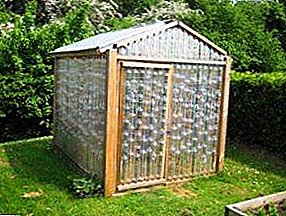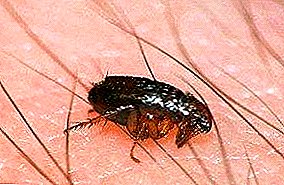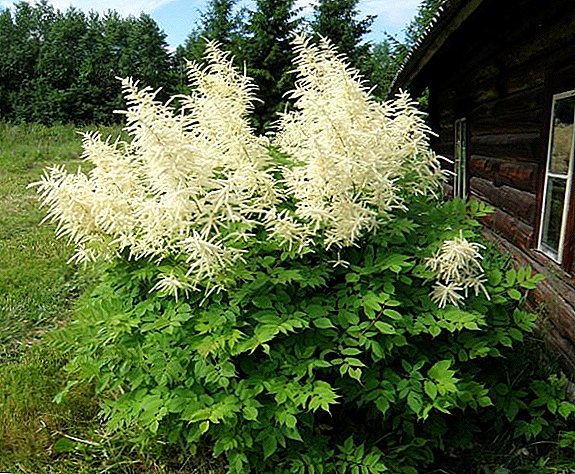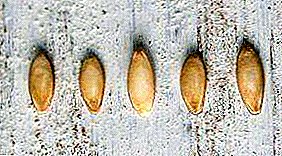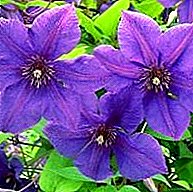
Recently, clematis enjoy deserved love florist.
Abundant flowering, dense foliage look very nice on the plot.
Many lovers have several types of clematis. But these plants, like many others, are prone to various diseases and pests.
Dangerous Clematis Diseases
Fungal diseases
The following fungal diseases are distinguished from clematis diseases:
 1. Withering - the most dangerous fungal disease, due to the fact that clematis has a root system that can go into the soil for 1 m.
1. Withering - the most dangerous fungal disease, due to the fact that clematis has a root system that can go into the soil for 1 m.
A seemingly healthy flower suddenly becomes sluggish shoots, which then wither.
The disease is caused by spores of a fungus that lives deep in the soil. It clogs the blood vessels, because of which the metabolism is violated and the escape will fade.
Most often, wilting is observed in early spring after a warm winter, as well as from stagnant water, plant shading. The disease often happens during the period of intensive growth, as the plant tissues work most quickly, and the plant will wither in a few hours.
2. Gray rot can be recognized by brown spots on the shoots and leaves. Spores spread quickly, and clematis can infect other neighboring plants.
There is a gray rot in rainy years. For treatment and prophylaxis, it is necessary to spray and water the bush with a solution of foundationol.
About methods of reproduction of clematis read on our website.
Clematis pruning groups can be found here.
We do an archway for clematis with our own hands: //rusfermer.net/sad/tsvetochnyj-sad/klematis/oporya-svoimi-rukami.html
3. Leaf spot (ascohitosis) expressed in the appearance of brown spots with a clearly defined edge on the leaves: they become brittle and the spots may crumble to form holes.
Spotting leads to disruption of photosynthesis and weakening of clematis, which reduces its flowering. Affected leaves must be removed and sprayed with a solution of copper sulfate.
 4. Mealy dew affects shoots, leaves, flowers.
4. Mealy dew affects shoots, leaves, flowers.
Clematis is covered with white bloom, under which the fabric dies.
Stops the growth and flowering plants. Powdery mildew most often occurs during the hot summer months, mainly in the southern regions.
For prophylaxis in spring, the damaged shoots are cut off and sprayed with a solution consisting of 30 grams of copper sulphate and 300 grams of soap diluted in 10 liters of water. Effective and spraying soda ash solution.
5. Rust manifested in the appearance on the leaves and shoots of clematis red pads, which are spores of the fungus. This leads to wilting of the leaves.
At the first signs of the disease, it is necessary to cut out the damaged leaves and shoots and sprinkle the plant with 2% Bordeaux mixture.
 6. Alternaria - dying off of weakened leaves, observed in August-September.
6. Alternaria - dying off of weakened leaves, observed in August-September.
Called a fungus that settles on the old parts of the plant and causes necrosis. But with a strong defeat, he can go on healthy leaves and shoots.
For the fight are effective all copper-containing drugs.
7. Septoria can be identified by gray spots with a reddish edge. Due to leaf damage, photosynthesis is disturbed, the plant becomes weak. For treatment, spray 1% solution of copper sulfate or Bordeaux liquor.
Viral diseases
Rarely, but clematis suffer from viral diseases:
1. Yellow leaf mosaic caused by viruses that spread sucking insects. There is no effective treatment, so it is better to remove the damaged plants.
For prevention, you do not need to plant near the delphinium, the host, peony, bulbous. After trimming plants in the garden you need to handle the tools with a disinfectant solution.
Colorless flowers appear due to improper fertilizer, insufficient lighting and heat. When eliminating the causes, the plant recovers.
Proper clematis care will not be ineffective.
With varieties of white varieties of clematis, can be found by clicking on the links: //rusfermer.net/sad/tsvetochnyj-sad/klematis/sorta.html
Clematis Pests
Clematis may be affected by pests.
 1. Nematodes found on the roots or leaves of clematis.
1. Nematodes found on the roots or leaves of clematis.
If, when digging up a plant, they are found on the roots, then new clematis should not be planted on this place for several years.
Worms that damage the leaves cause them to dry out and die.
Pests penetrate the damaged plant from weeds or from the soil.
For prophylaxis, it is recommended to use only healthy plants for reproduction, to regularly fight weeds. With a strong infection clematis is better to destroy and disinfect the soil.
Sometimes they give a good result in the fight against the nematode beside planted marigolds, garlic, parsley, dill, coriander, calendula.
2. End Moth - butterfly with brown wings and golden spots. Prints small yellow caterpillars, on the body of which there are warts. The caterpillars feed on clematis leaves, incising and twisting them into a tube.
3. Butterfly - the moth has greenish wings, appears in June-July. Lays green pupae between leaves of clematis. Hands need to collect the caterpillars and destroy them, spray clematis before flowering "Agravertinom."
4. Beet aphid accumulates on the underside of the leaves of clematis, sucking the nutrients out of them. To fight you need to spray any insecticide.
5. When attacking spider mite the leaves turn yellow, the buds dry up, a spiderweb appears on the plant.
Good for getting rid of the parasite helps infusion of garlic - 200 grams per 10 liters of water. It is possible to use a solution of colloidal sulfur, actelic for spraying.
6. Slugs and snails destroy young shoots, especially they are dangerous in the spring, when the plant is just awakening.
To collect the parasites, cabbage leaves are laid out as baits, sprinkled with ash on their places of movement.
Read on the site how to get rid of aphids on your site.
Effective methods of protection from wireworms: //rusfermer.net/ogorod/vrediteli-ogorod/borba/kak-izbavitsya-ot-provolochnika-v-ogorode.html
Prevention methods
1. For the prevention of all fungal diseases in early spring and late autumn, it is useful to water the soil around clematis with a solution of foundationol (20 g per 10 l of water), and also sprinkle the shoots.
2. It is recommended to mulch the soil around clematis with wormwood, mint, and to apply fertilizers, which include ammonia.
3. Timely destruction of weeds, removal of diseased parts of clematis.
4. In the vicinity of clematis, it is necessary to periodically change the transplanted plants in order to protect it from parasites, for example, from gall nematodes. The change of crops not only prevents the parasites from developing, but also heals the soil.
 5. It is very important to plant healthy plants. Infected cuttings can become a source of infection and infect not only clematis, but also other plants.
5. It is very important to plant healthy plants. Infected cuttings can become a source of infection and infect not only clematis, but also other plants.
6. Pests are well removed by singing birds, so you need to create the conditions for their involvement.
If preventive measures are taken, the plants will be sick less often, delighting florists with abundant flowering.
Clematis are affected by diseases and parasites no more than other colors, but infection is better to detect at the initial stage, then it will be much easier to cure the plant. With good conditions, this vine can live up to 50 years.


 About methods of reproduction of clematis read on our website.
About methods of reproduction of clematis read on our website. Proper clematis care will not be ineffective.
Proper clematis care will not be ineffective. Read on the site how to get rid of aphids on your site.
Read on the site how to get rid of aphids on your site.